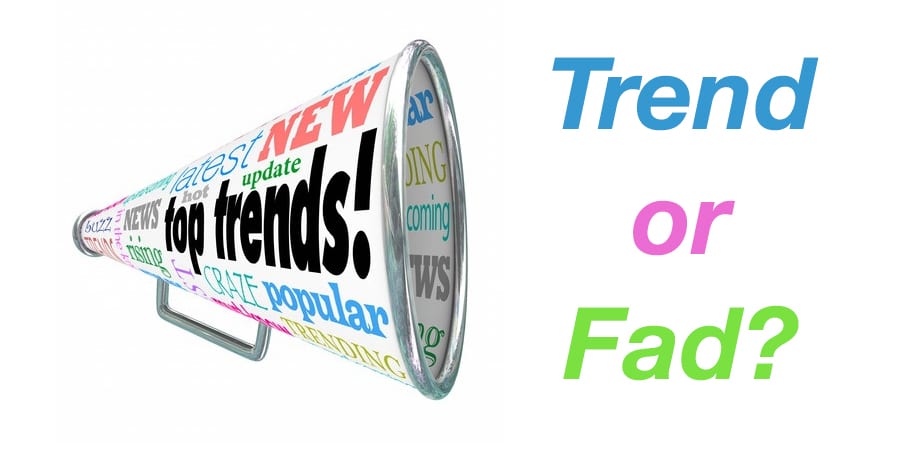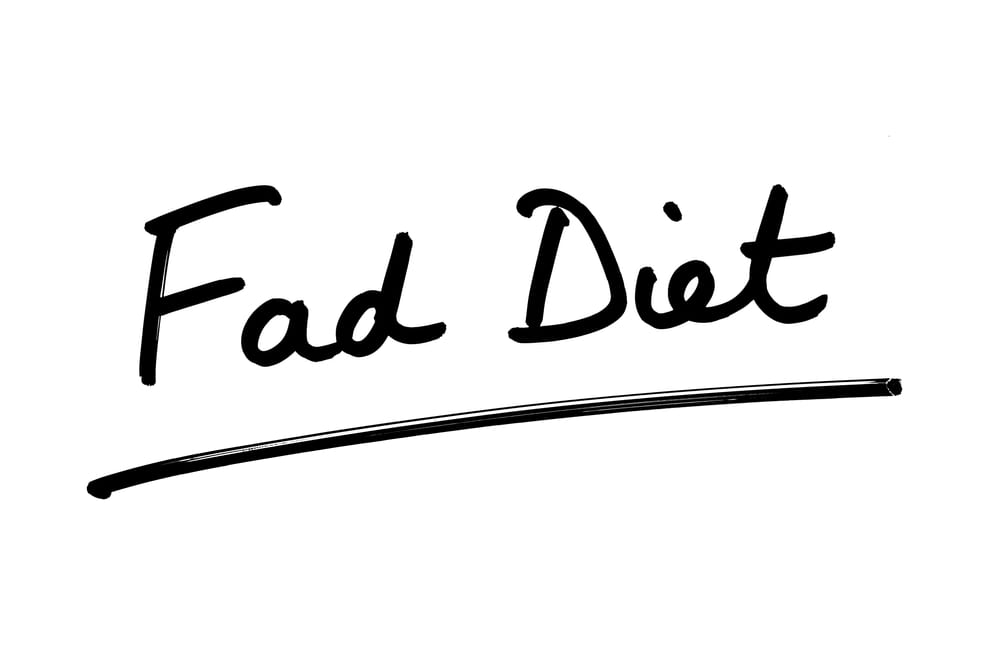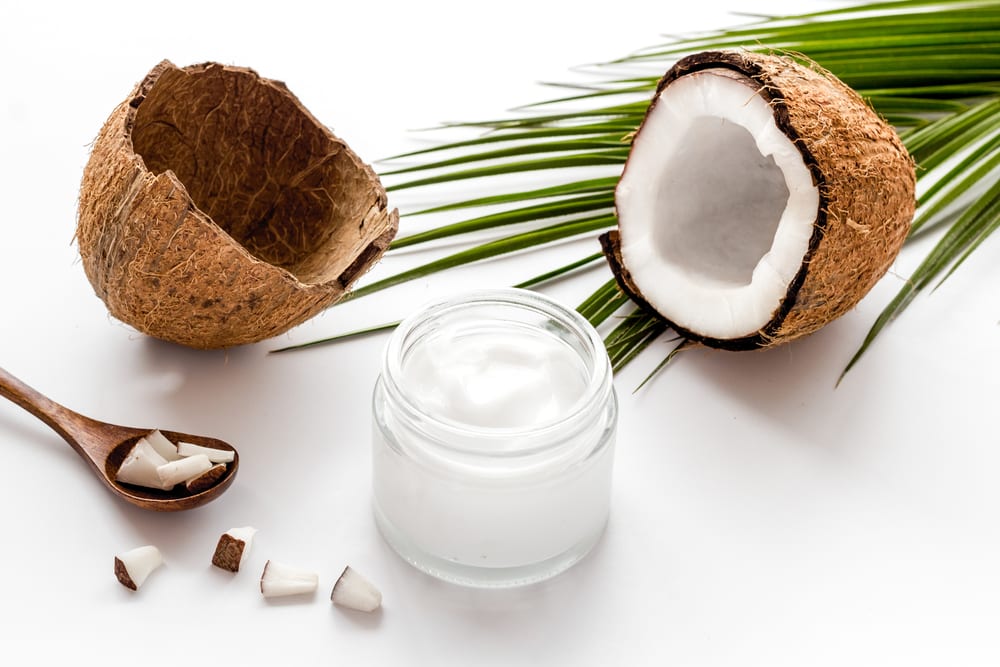
At the end of the year, we’re reminded to make a New Year’s resolution. These resolutions can help us list our priorities and work towards self-improvement.
Since this year was the start of a new decade, it’s been a big year for consumers looking to make a change. The growing health and wellness market has seen an increase in trends and fad-products. Businesses must know the difference between trends and fads to understand what their customers are looking for and when.
We’ll walk you through the differences and similarities. Once you understand fads and trends, you’ll understand more about your customers.
What trends do you customers follow? What fads do they want to try?
What Are Health & Wellness Fads?

A Trend vs Fad
Fads never last long. People get excited by a fad for a short amount of time, then it loses popularity when the novelty wears off. Fads make sudden changes in the market as consumers buy the new, popular product. They rarely change a consumer’s habits.
Fads appear across the market. In the health and wellness industry, the most popular fads are usually based on the idea of restricting a food type of group from the diet. These fads claim to give fast weight loss or other amazing health results. Often these promises aren’t backed up by substantial scientific evidence.
When scientific evidence was published suggesting that high carbohydrate intake can increase the weight we gain, multiple fad diets appeared on the market. Some fad diets may claim to have fantastic health benefits such as treating symptoms of cancer.
You may be familiar with some fad diets such as paleolithic and gluten-free diets. Some diets started as a fad (Atkins diet, for example) but managed to last in the market.
Fad products typically have excellent advertising and marketing campaigns. They are designed in a way to lead customers to purchases by making big claims about weight loss and health benefits. While consumers may experience weight loss on fad diets, they usually regain the weight shortly afterward.
Fad products can be appealing for their big promises and convenience. Consumers can find the idea of losing weight quickly without permanently changing their lifestyle appealing, for example.
So what are some examples of fad products available in the health and wellness market?
When A Fad Turns Into A Trend – Stevia as a Sugar Replacement

Some fads can provide beneficial effects for health and well-being in some people, even if the consumer only uses the product for a short period. Stevia is a well-known product that was once just a fad. It is a sugar substitute, said to be at least 10 times sweeter than sugar, but without the negative health baggage of sugar.
Stevia became popular as a zero-calorie sweetener that is safe for those who have diabetes. Although the FDA had some early concerns in the 90s, Stevia eventually received approval in 2008 (1). This made the Stevia market boom. While the original has managed to merge into the market and make its place on our shelves, other stevia products attempt to copy the same success.
‘Stevia rebaudiana’ is the name of the plant that is used to make the sweetener. Products that mix stevia with some kind of sugar base may not be as effective as the pure plant strain (2).
What Are Health & Wellness Trends?

So, fads make a quick change in the market and are usually of short term interest to consumers. But a fad can actually turn into a trend!
Trends are a slow and steady build in the market. Trends can impact a customer’s buying decisions and change their purchasing habits. Unlike fads, trends have great long term potential to influence the health and wellness market.
It can be difficult to tell when a trend is emerging as we have to analyze a few different categories. Trends are defined by three factors. They need to be in the right place, at the right time, and with the right customers. A fad could have become a trend if it had been released at a different time.
For those in the health and wellness industry, we know that getting a trending product can unlock new opportunities in business. By understanding our customer’s behaviors, wants, and needs, we can try to predict the sorts of products they will want in the present and future. What makes a trend in the health and wellness industry? There are three things you need to know.
The Coconut Oil Trend

Maybe you’ve noticed the eruption of coconut oil on the market. Unprocessed, virgin coconut oil can be found in the health and wellness market for multiple purposes.
You’ve seen it used in DIY hacks and even tooth cleaning. Coconut oil became popular for its high medium-chain-triglycerides (MCTs) content, which has been used as the basis for marketing campaigns in reducing acne, as a natural base in makeup products, and a quick ingredient to a pre-workout smoothie to optimize results.
Some aspects of fad or trending products are based on scientific claims to be more appealing to consumers. There is evidence, for example, that MCTs can help to improve brain function and muscle performance (3).
The Three Characteristics of a Trend
Trends are usually driven by new customer behavior, new opinion, or new expectations. Typically, a customer’s basic needs (status, self-improvement, etc) are stable. The health and wellness industry adapts products to address consumer needs in new ways. Changes made to products or new services offered start the foundation for a trend.
Basic Needs
According to Maslow’s Hierarchy of Needs theory, we all have basic needs that have to be met for our happiness and wellbeing (4). Basic needs are related to our daily habits and greatly impact our health. Getting enough sleep and access to clean water, for example. Trends might also address other needs such as our self-esteem and give us a sense of connection with others.
If you understand human needs, you’ll be able to spot a growing trend much easier.
Shifts & Triggers
There’s one question your need to ask: “what is changing?” We’re always looking for new ways to meet the needs of consumers in new ways.
You should be looking for shifts in consumer behavior. Shifts are big changes such as having an aging population that can take many years to take effect in the market but knowing it’s coming can help you prepare for the upcoming trend.
Triggers, however, are quick events that change consumer behavior almost immediately. A political event, economic recession, or an earthquake can all trigger a change in behavior. They can be unpredictable, but reacting quickly can keep you ahead of the curve.
Innovations
Without innovations, we can’t fully take advantage of a rising trend. Try to keep track of new changes in the market and industry. New products can address customer concerns in new ways and can, potentially, become a trend.
In the health and wellness industry, we’ve seen a rising trend in dietary supplements. According to recent reports, Americans are interested in taking control of their wellbeing and so are spending more on health and wellness products.
Did you know that dietary supplements are part of the daily routine for about three-quarters of U.S. consumers? (5)
You should be aware of the rising trends in your sector. Health and wellness trends are based on individual choices and establishing or improving their lifestyle. We’ve seen recent trends in the market, including biohacking (6).
Trends & Fads for Business

Do you want to build a successful business or product? Without the right analysis, you could end up wasting type making a fad and not a trend. This can result in you losing business opportunities. While a fad’s short term boom is better than none at all, we all want our products to last a long time in the market.
If a business is built on fads, it needs to adapt constantly to the consumer market. It needs to quickly change when consumer attitudes change and are more vulnerable to trigger changes. Fads might boost your business in the short term, but it’s a much smarter business plan to have a long term strategy instead that is based on consumer trends.
Keeping an eye on trends will allow for higher customer engagement, better business strategy, and help your products successfully compete in the marketplace in the long run.
A business may ignore trends to avoid risks. But this means the business will have to adapt their products later to stay competitive when the market changes or risk being left behind. It can be overwhelming to analyze trends. When you’re making your strategy, there are a few things you need to ask to make sure your product has a chance at becoming a trend.
Is The Brand’s Messaging Connected to Drivers of Chance?
Brands succeed when they address the current situation with timely, thoughtful strategies.
Trends flourish because they result from social, political, economic, technological, or environmental change. Make sure your messaging is formulated from one of those categories. On the other hand, fads are not driven by any real long-term motivation or goal.
Will Your Brand’s Message Still be Relevant 5 Years From Now?
Trends continue to rise over time. Predictions can help us tell if a product is going to last a long time in the market.
One long term trend you may know is the vegan lifestyle. In the 2000s, vegan products started to gain traction but were dismissed as a fad by some. Now, years later, vegan and plant-based products are booming in the health and wellness industry. Vegan products have latched onto concerns about climate change and health concerns in general.
Veganism is an ever-growing trend that companies need to be aware of. According to research by GlobalData, there has been a 600% increase in the number of Americans identifying themselves as vegan from 2014 to 2017 (7). Should businesses ignore this trend, they are missing an opportunity to capitalize on a growing market need.
The confluence of these three factors outlined above indicates how a brand identifies trends. Here are more questions with examples to think on:
Is This Emerging Need Likely to Grow And to Sustain Over Time?
Tracking consumer behavior can give us a better idea of what they will want in the long term. One growing trend we have seen is meditation. Certainly, meditation isn’t a fad now. If your product is linked to growing concerns about improving the emotional state, focus, and overall well-being then it may become a trend just like meditation.
Is This Emerging Need Based Mostly on Novelty?
If your product is based on novelty, it’s likely to be a fad and not a trend. Once you have decided on what your customer’s needs are, you can look at current trends and analyze your competitors. You should understand what the current trends are to avoid making a fad product.
One emerging need is the demand for plant-based meats. More than a fad, this is based on the rise of the vegan lifestyle and health concerns. Forbes also predicts that plant-based meats will be a big trend of 2020 (8). A product aimed at a customer’s long term lifestyle choices is more likely to last longer on the market.
Conclusion
Trend vs fad – Fads and trends can both benefit businesses. Understanding the differences between them is essential to make a good, long-lasting business strategy. The market is innovating new products all the time to meet customer’s changing attitudes and needs.
Keeping track of current trends can help your business beat the competition. Labeling your product correctly for trends can help your product stand out.
Manufacture Your Supplements With SMP Nutra
Looking to sell trending supplements? Having high-quality supplements is crucial to the success of this venture. SMP Nutra is a leading supplement manufacturing facility that can manufacture any type of supplement.
We are capable of producing capsules, softgels, tablets, gummies, and more. We also offer design services to make your supplement look professional and attractive.
References:
- https://progressivegrocer.com/stevias-fda-approval-propels-sales-and-cpg-use
- https://www.ncbi.nlm.nih.gov/pmc/articles/PMC4890837/
- https://www.ncbi.nlm.nih.gov/pmc/articles/PMC5805166/
- https://www.thoughtco.com/maslows-hierarchy-of-needs-4582571
- https://www.crnusa.org/newsroom/dietary-supplement-use-reaches-all-time-high
- https://www.entrepreneur.com/article/340355
- https://foodrevolution.org/blog/vegan-statistics-global/
- https://www.forbes.com/sites/jennifercohen/2020/01/08/wellness-trends-for-2020/#5e74d8fc4177

